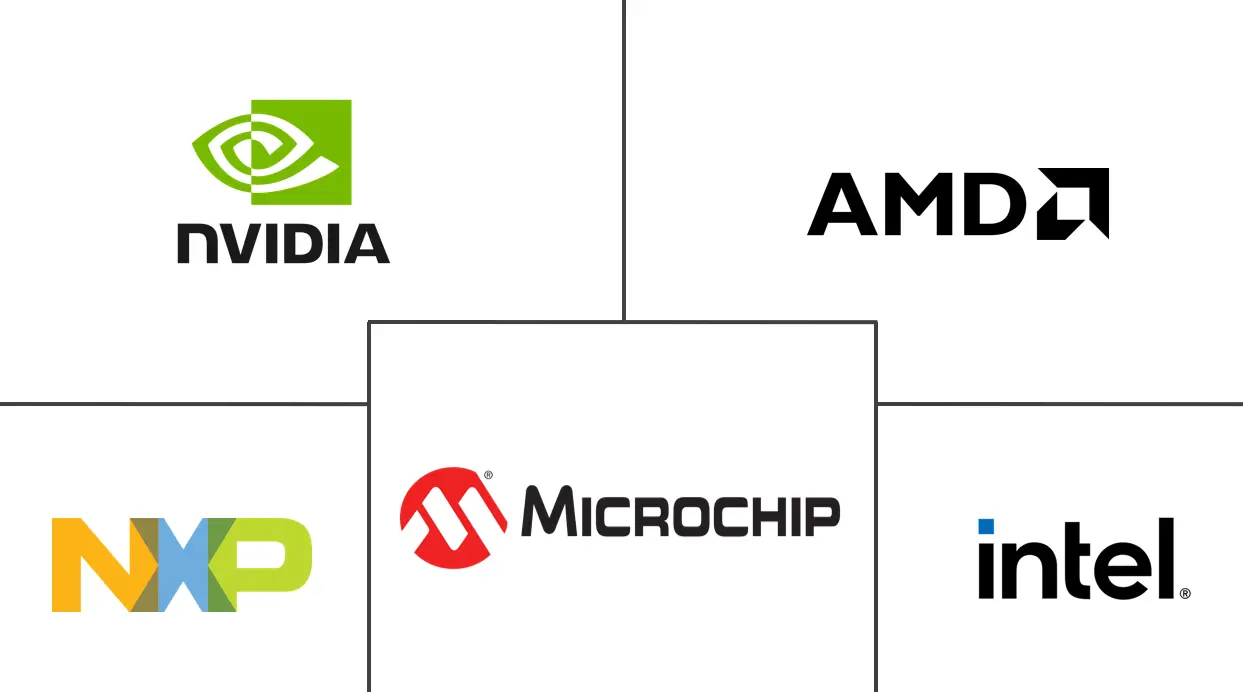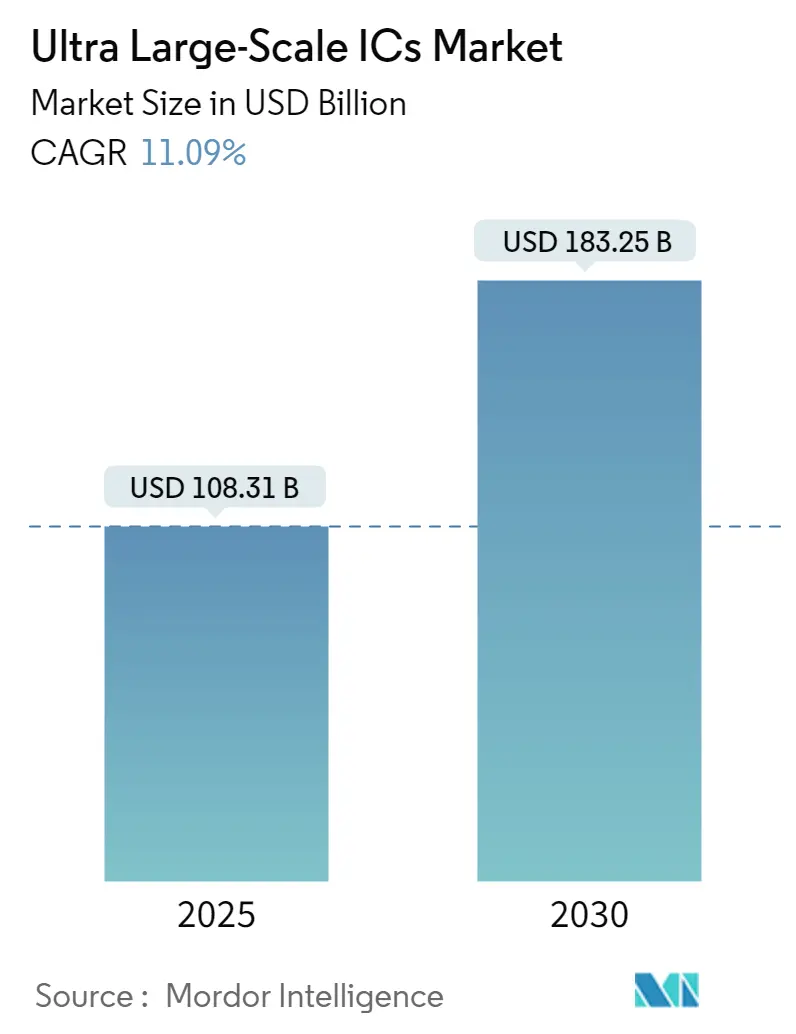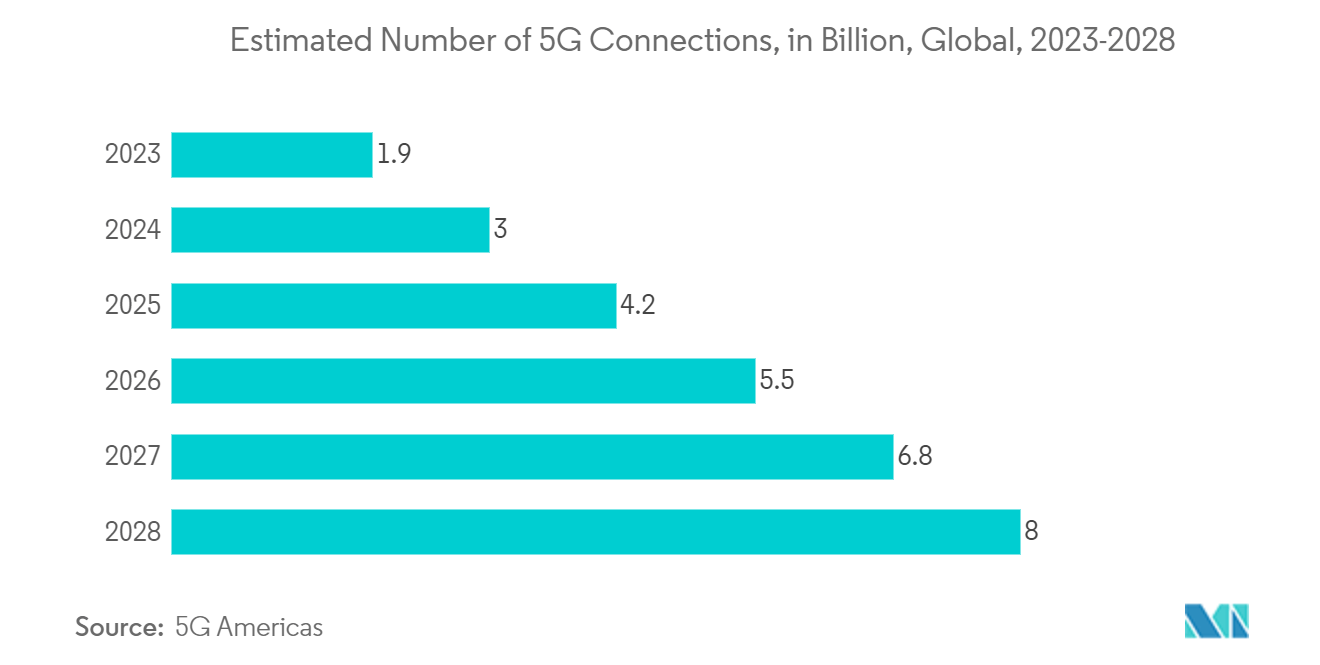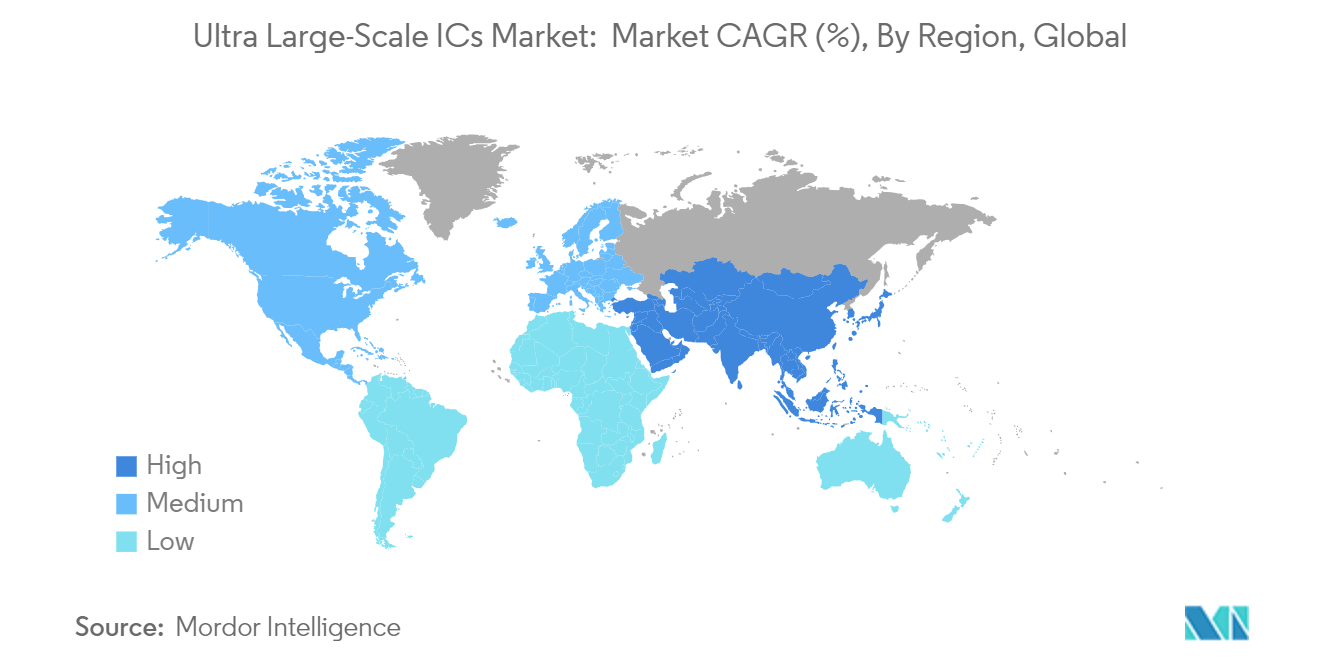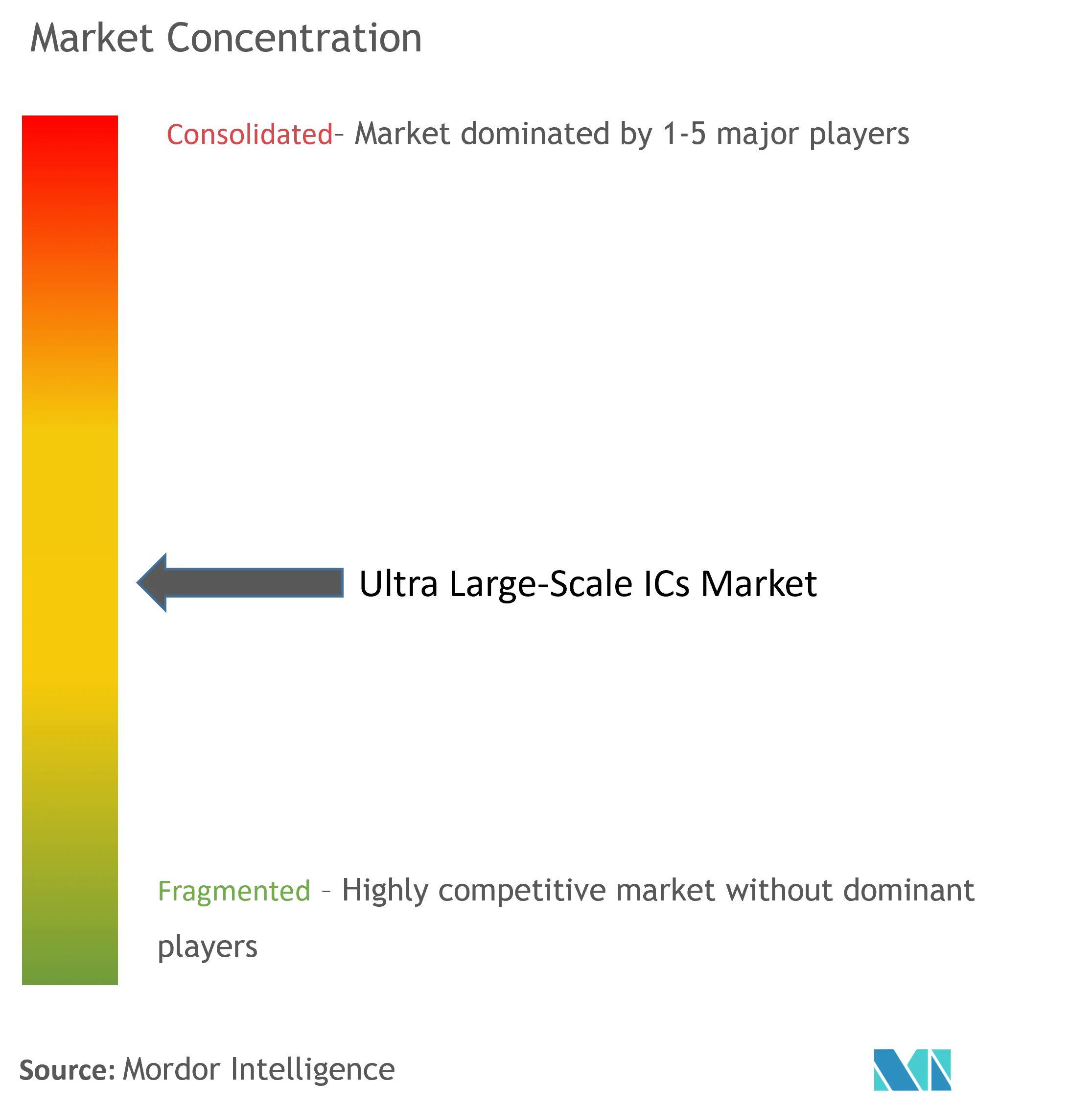Ultra Large-Scale ICs Market Analysis
The Ultra Large-Scale ICs Market size is estimated at USD 108.31 billion in 2025, and is expected to reach USD 183.25 billion by 2030, at a CAGR of 11.09% during the forecast period (2025-2030).
Ultra large-scale integration (ULSI) maximizes computational power while minimizing the microchip's size. This was accomplished by embedding and integrating circuits (ICs) formed from transistors and logic gates. The ULSI architecture facilitates quicker task and process resolutions. An IC is classified as ULSI if it houses over one million transistors.
- The market plays a pivotal role in the expansive semiconductor industry, where millions, or even billions, of transistors are integrated into a single chip. These circuits form the backbone of contemporary electronics, propelling progress across diverse sectors. This technology fuels swift innovations in domains like AI, high-performance computing, 5G, and autonomous vehicles, cementing its status as a cornerstone of the global economy.
- A prominent trend is the relentless miniaturization of transistors, driven by shrinking technology nodes. Ongoing research investments aim to develop sub-nanometer-sized transistors. A study in Nature Technology highlights a breakthrough by an Institute for Basic Science (IBS) team, who achieved epitaxial growth of 1D metallic materials under 1 nm in width. Such advancements are poised to bolster the market's growth trajectory significantly.
- AI chips are specialized integrated circuits tailored for AI tasks. They encompass graphics processing units (GPUs), field programmable gate arrays (FPGAs), and application-specific integrated circuits (ASICs). The surge in demand for AI-driven applications has spurred the evolution of AI accelerators and machine learning processors. These chips, adept at managing intensive computing tasks and vast datasets, find increasing relevance in data centers and advanced robotics, propelling the market's growth.
- The global 5G network rollout and the burgeoning IoT ecosystem are primary catalysts. High-performance ICs are the backbone of 5G infrastructure, from base stations to networking equipment. Concurrently, IoT devices, often limited by size and power, reap benefits from these technological advancements. Furthermore, innovations in chip packaging and quantum computing are expected to boost the market.
- Yet, the market grapples with challenges. As Ultra Large Scale technology pushes to smaller nodes, production complexity and costs surge. The drive toward tinier transistors encounters hurdles like quantum tunneling and heat dissipation. At nanoscale dimensions, phenomena like electrons tunneling through insulating barriers can lead to unintended current flows, jeopardizing reliability.
- Key industry players are ramping up investments to bolster their semiconductor manufacturing prowess. Governments, especially in the United States, Europe, China, and India, are rolling out substantial investments and incentives to amplify domestic semiconductor production. The United States CHIPS Act stands out, while Europe champions semiconductor self-sufficiency through initiatives like the European Chips Act. Meanwhile, emerging economies in Asia Pacific are witnessing an increasing demand for consumer electronics, automotive tech, and industrial automation, intensifying the need for advanced chips creating a favorable ecosystem for the market's growth.
Ultra Large-Scale ICs Market Trends
The Telecommunication Segment is Expected to Witness an Increase in Demand
- The telecommunication sector, especially with the ongoing rollout of 5G networks and the rapid expansion of next-generation communication technologies, plays a pivotal role in driving the market. The global rollout of 5G stands out as the most significant catalyst. Unlike its predecessors, 4G and 5G demand faster data transmission, emphasizing low latency, high bandwidth, and the capability to support many connected devices.
- Ultra large-scale circuits are central to these advancements, offering the computational power needed for signal processing, network slicing, and real-time data management across expansive and dense networks. Furthermore, the multiple input multiple output (MIMO) technology, crucial for 5G deployment, relies on advanced chips for efficient communication and power management.
- Moreover, the push for low power consumption in mobile networks and the rise of edge computing and IoT applications amplifies the demand for ultra large-scale technology to guarantee energy-efficient solutions. With the advent of 5G, there is a notable transition from centralized cloud computing to edge computing. This paradigm shift means data processing happens closer to its source, such as telecom towers or IoT devices, reducing latency and swifter data transmission.
- Ultra large-scale integrated circuits are pivotal in managing the surging data volumes from IoT devices, ensuring prompt real-time processing. As the IoT ecosystem burgeons, with billions of devices anticipated to connect to networks by the decade's end, telecommunication providers play a crucial role in facilitating this communication. From smart home products to industrial sensors, IoT devices demand highly integrated, low-power advanced chips for effective wireless communication, which is expected to drive opportunities in the market.
- Data from 5G Americas indicates a significant growth trajectory: the number of 5G connections is projected to increase from 1.9 billion in 2023 to about 8 billion by 2028. This surge, driven by 5G service providers and the growing acceptance of consumers, compelling telecom operators to enhance their infrastructure with advanced chips. These upgrades are essential for managing vast data throughput and ensuring uninterrupted connectivity, which in turn creates opportunities in the market.
North America is Expected to Hold a Significant Share in the Market
- North America, spearheaded by the United States, commands a significant market share. The region's dominance stems from a robust demand for cutting-edge technologies across various sectors, notably telecommunications, artificial intelligence (AI), autonomous vehicles, cloud computing, and defense. Substantial investments in semiconductor manufacturing and R&D, complemented by government policies that bolster domestic chip production, further strengthen North America's leadership in advanced chip production and innovation.
- North America leads the charge in 5G network deployment, with major telecom players like Verizon, AT&T, and T-Mobile aggressively rolling out their 5G infrastructure. This swift expansion fuels the demand for ultra large-scale ICs. Furthermore, regional telecom operators are channeling investments into Millimeter Wave (mmWave) technology to boost 5G network performance. Such advancements necessitate specialized chips adept at handling higher frequencies, ensuring ample bandwidth for data-intensive applications like IoT and autonomous vehicles.
- AI applications significantly drive the demand for ultra large-scale ICs. Major tech giants, including Google, Microsoft, and Nvidia, heavily invest in AI accelerators, machine learning models, and neural network processors, which demand high-performance chips. These chips play a dual role: training AI models and executing real-time inference tasks.
- The surge of data centers in North America, largely fueled by the ascent of cloud and edge computing, amplifies the demand for semiconductors. Hyperscalers such as Amazon Web Services (AWS), Google Cloud, and Microsoft Azure are bolstering their data center capabilities, intensifying the need for state-of-the-art semiconductor solutions that optimize power and performance. Data from CBRE Group highlights this trend: the power supply for data centers under construction in the United States surged from 0.22 gigawatts in 2016 to 3.1 gigawatts in 2023.
- As a nexus for autonomous driving and electric vehicle innovation, North America is witnessing companies crafting advanced driver assistance systems (ADAS) and fully autonomous driving platforms, both reliant on intricate integrated circuits. Moreover, a pivotal development in the North American landscape is the US Chips and Science Act, poised to significantly propel the market's growth.
Ultra Large-Scale ICs Industry Overview
The market is moderately competitive, featuring a blend of global semiconductor behemoths and niche manufacturers. Key drivers of this competition include technological advancements, R&D investments, production capabilities, and responsiveness to demands from sectors like telecommunications, automotive, artificial intelligence (AI), and consumer electronics.
Prominent players in the arena include Intel Corporation, Samsung, Nvidia Corporation, and AMD. These competitors are channeling investments into cutting-edge process technologies and chip architectures. With billions funneled into R&D, they are keen to maintain a forefront position in innovation. Companies like Apple and Google are crafting their chips, tailoring performance to their unique requirements.
These firms gain tighter control over hardware and software through vertical integration, diminishing their dependence on external suppliers. For example, Apple's M Series chips and Google's Tensor Processing Units; these in-house designs boost product performance and set them apart in the market. Moreover, strategic alliances between foundries and fabless entities are paving the way for the mass production of the latest designs.
Ultra Large-Scale ICs Market Leaders
-
Nvidia Corporation
-
Advanced Micro Devices, Inc.
-
Intel Corporation
-
NXP Semiconductors
-
Microchip Technology
- *Disclaimer: Major Players sorted in no particular order
Ultra Large-Scale ICs Market News
- September 2024: The National Science Foundation granted approximately USD 600 thousand to Zhuo Feng, a professor in the Department of Electrical and Computer Engineering at the Stevens Institute of Technology. The project aims to simplify the modeling, design, and verification of intricate computer chips. This endeavor is crucial, as simulating a sizable circuit block can span days or weeks. Moreover, optimizing and verifying the complete chip may necessitate hundreds or even thousands of such simulations.
- March 2024: Cerebras Systems, a leading force in the generative AI landscape, intensified its focus on its fastest AI chip by unveiling the Wafer-Scale Engine 3 (WSE-3). The WSE-3 is meticulously designed to train the industry's most expansive AI models with double the performance of its predecessor. Built on a 5nm architecture and housing 4 trillion transistors, the WSE-3 fuels the Cerebras CS-3 AI supercomputer, achieving a remarkable 125 petaflops of peak AI performance via its 900,000 AI-optimized compute cores.
Ultra Large-Scale ICs Industry Segmentation
Ultra-large-scale Integrated Circuits (ICs) are an advanced type of integrated circuit that contains millions or even billions of transistors on a single chip. This technology enables high-performance, compact, and energy-efficient devices by integrating numerous functions, such as processing, memory, and communication, into one semiconductor chip. It is a critical component in modern electronics powering various high-demanding applications.
The study tracks the revenue generated from the sale of ultra large-scale ICs by various manufacturers across the world. It also tracks the key market parameters, underlying growth influencers, and major manufacturers operating in the industry, which supports the market estimations and growth rates during the forecast period. The study further analyses the overall impact of macroeconomic factors on the market. The report’s scope encompasses market sizing and forecasts for the various market segments.
The ultra large-scale ICs market is segmented by type (thick film ICs and thin film ICs), application (consumer electronics, automotive, telecommunication, data centers, and healthcare), and geography (North America, Europe, Asia-Pacific, Latin America, and Middle East and Africa). The market sizes and forecasts are provided in terms of value (USD) for all the above segments.
| By Type | Thick Film ICs |
| Thin Film ICs | |
| By Application | Consumer Electronics |
| Automotive | |
| Telecommunication | |
| Data Centers | |
| Healthcare | |
| Other Applications | |
| By Geography*** | North America |
| Europe | |
| Asia | |
| Australia and New Zealand | |
| Latin America | |
| Middle East and Africa |
Ultra Large-Scale ICs Market Research FAQs
How big is the Ultra Large-Scale ICs Market?
The Ultra Large-Scale ICs Market size is expected to reach USD 108.31 billion in 2025 and grow at a CAGR of 11.09% to reach USD 183.25 billion by 2030.
What is the current Ultra Large-Scale ICs Market size?
In 2025, the Ultra Large-Scale ICs Market size is expected to reach USD 108.31 billion.
Who are the key players in Ultra Large-Scale ICs Market?
Nvidia Corporation, Advanced Micro Devices, Inc., Intel Corporation, NXP Semiconductors and Microchip Technology are the major companies operating in the Ultra Large-Scale ICs Market.
Which is the fastest growing region in Ultra Large-Scale ICs Market?
Asia Pacific is estimated to grow at the highest CAGR over the forecast period (2025-2030).
Which region has the biggest share in Ultra Large-Scale ICs Market?
In 2025, the North America accounts for the largest market share in Ultra Large-Scale ICs Market.
What years does this Ultra Large-Scale ICs Market cover, and what was the market size in 2024?
In 2024, the Ultra Large-Scale ICs Market size was estimated at USD 96.30 billion. The report covers the Ultra Large-Scale ICs Market historical market size for years: 2019, 2020, 2021, 2022, 2023 and 2024. The report also forecasts the Ultra Large-Scale ICs Market size for years: 2025, 2026, 2027, 2028, 2029 and 2030.
Ultra Large-Scale ICs Industry Report
Statistics for the 2025 Ultra Large-Scale ICs market share, size and revenue growth rate, created by Mordor Intelligence™ Industry Reports. Ultra Large-Scale ICs analysis includes a market forecast outlook for 2025 to 2030 and historical overview. Get a sample of this industry analysis as a free report PDF download.

